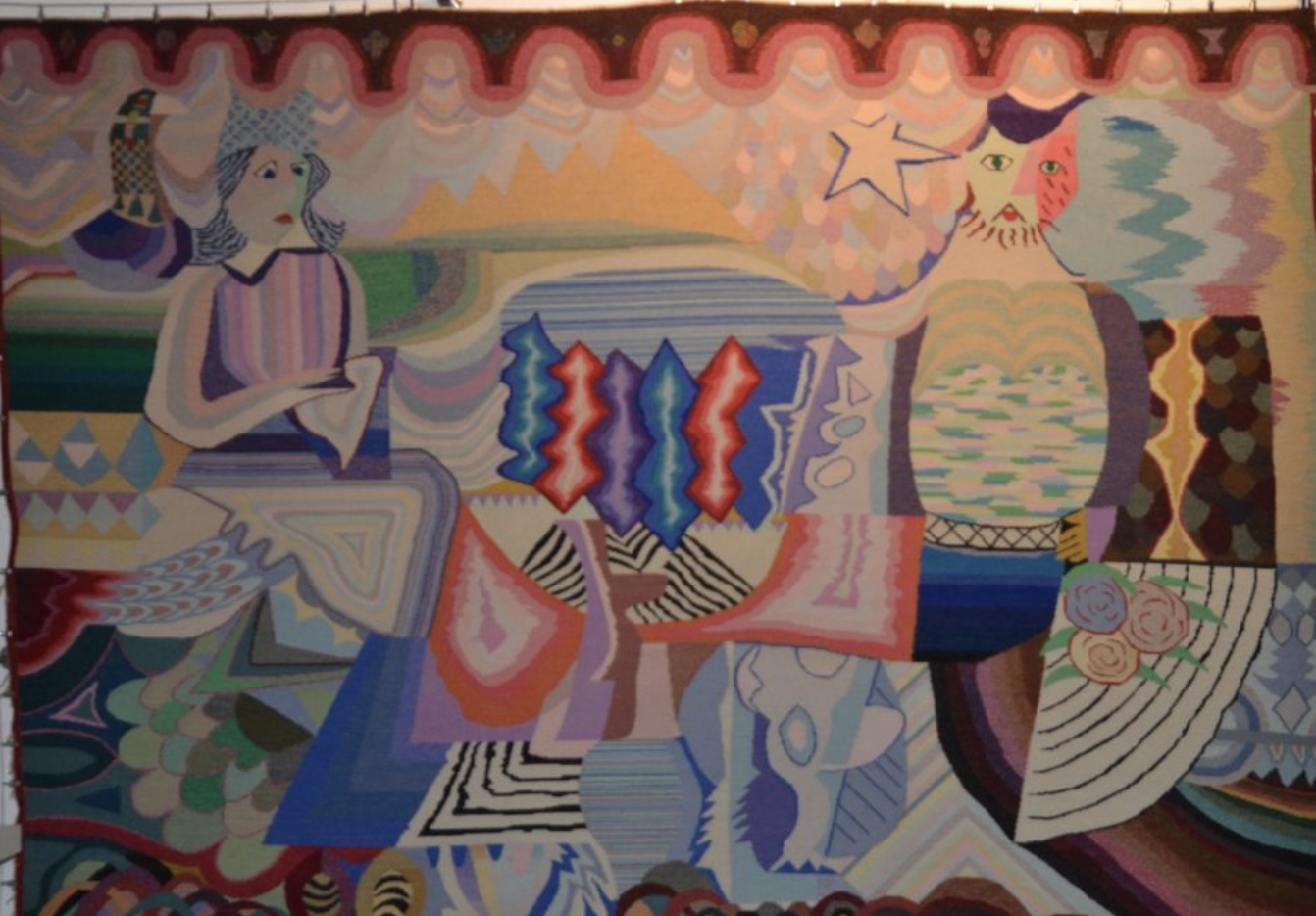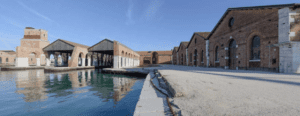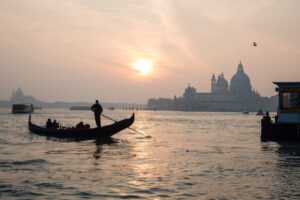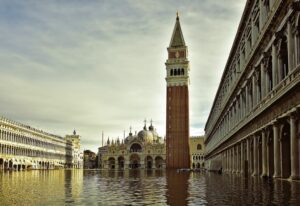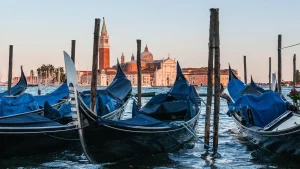Casa Museo Andrich — The Artistic Soul of Torcello
When most travelers hear the name Torcello, they think of ancient mosaics, Attila’s Throne, and the solemn majesty of the Cathedral of Santa Maria Assunta. But hidden among this island’s gardens and canals lies another treasure — a place where modern creativity flourished amidst ancient history: Casa Museo Andrich.
This quiet house, half museum and half sanctuary, tells the story of two remarkable Venetian artists — Lucio Andrich and his wife Giovanna Andrich — who transformed their Torcello home into a living masterpiece. Visiting it is like stepping into an intimate dialogue between art and nature, tradition and innovation, the past and the present of the Venetian lagoon.
Far from the selfie sticks and souvenir stalls of Venice, the Casa Museo Andrich offers travelers something different — an encounter with the soul of Venice itself, seen through the eyes of artists who loved and lived it deeply.
🌾 Torcello: The Perfect Canvas for a Life of Art
Before exploring the Casa Museo, it helps to understand the place that shaped it. Torcello is not like Murano or Burano. It has no crowds, no glass furnaces, no lace stalls. Its soundscape is wind, birdcalls, and the soft ripple of canals bordered by reeds. Today, fewer than 15 people live here permanently. Time moves slowly, and history seems to hum beneath the surface of the grass.
Once the first great settlement of the Venetian lagoon, Torcello is now a place of profound stillness. Its empty fields and quiet waterways made it the perfect refuge for artists seeking peace and inspiration. One of its most famous residents, Ernest Hemingway, spent weeks here in the 1940s, writing parts of Across the River and Into the Trees while staying at the legendary Locanda Cipriani. He hunted duck at dawn, drank prosecco at sunset, and called Torcello “a place where your soul can rest.”
Two decades later, Lucio and Giovanna Andrich would follow in Hemingway’s footsteps — not as writers, but as visual poets of the lagoon. They too sought silence, reflection, and authenticity. They found it here, among the canals where civilization once began.
🎨 The Story of Lucio and Giovanna Andrich
From Venice to Torcello — A Creative Journey
Lucio Andrich (1927–2003) was born in Venice, a city where art flows as naturally as water. From a young age, he showed a passion for design and craftsmanship — not as separate disciplines, but as complementary expressions of beauty. His wife, Giovanna, shared his vision. Together, they built a partnership that was both artistic and deeply human.
In the 1950s, while Venice was rediscovering its modern identity through design and architecture, the Andrichs looked to the lagoon itself for inspiration. They moved to Torcello — an island of reeds and ruins — and transformed an old house into their home, studio, and sanctuary. It was a bold decision: to live surrounded not by marble and tourists, but by silence and sea breeze.
Their Philosophy: Art as a Way of Living
The Andrichs believed that art should not be confined to galleries or museums. It should be lived, touched, and integrated into everyday life. Their philosophy blurred the boundaries between art, craft, and nature — much like the lagoon blurs the line between land and sea.
Lucio’s work spanned many forms:
- Tapestries — woven with bold colors and patterns inspired by Venetian mosaics and water reflections.
- Mosaics and paintings — carrying forward a millennium-old tradition into modern design.
- Textile and object design — merging utility and elegance with Venetian motifs.
- Sculptures and installations — often placed outdoors, where wind, water, and sunlight became part of the composition.
Giovanna, also a talented artist, worked alongside him on textiles and interiors. Together, they created a “total work of art” — or, as the Germans would say, a Gesamtkunstwerk — where life and art became inseparable.
🏡 A House as a Living Work of Art
Their Torcello home is unlike any other in the lagoon. Casa Andrich is not merely a museum — it’s a living organism of creativity. The walls, floors, furniture, and even doorframes bear the mark of their imagination. Every surface seems to tell a story: mosaics embedded in floors, painted doors featuring abstract waves, handmade fabrics glowing in soft lagoon light.
Entering the Casa Museo feels like walking into a mind — the Andrich mind — where colors, textures, and natural forms flow seamlessly together. It’s deeply Venetian yet entirely personal: the lagoon interpreted not as geography, but as soul.
🖼 Inside the Casa Museo Andrich: What to See
1. The House and Atelier
Your visit begins in the private rooms where Lucio and Giovanna lived and worked. The studio still smells faintly of linseed oil and pigment; sketches and swatches lie across tables as if the artists just stepped out for a walk. Tools, brushes, and fragments of unfinished projects reveal their process — spontaneous, tactile, and full of curiosity.
2. Tapestries and Textiles
Lucio Andrich’s tapestries are the centerpiece of the collection. Woven on traditional looms, they combine Venetian symbolism with modern abstraction. Fish, boats, waves, and sunbursts dance across rich fabrics, recalling both Byzantine mosaics and the geometry of the 20th century. His palette — lagoon blues, terracotta reds, soft golds — mirrors the colors of Torcello at sunset.
3. Mosaics and Paintings
Venice’s art history is inseparable from mosaics, and Andrich saw himself as part of that lineage. His mosaic panels, many created with Murano glass tesserae, shimmer with the same light that fills the Cathedral of Santa Maria Assunta. But his approach was modern — abstract forms and fluid lines that evoke movement, not rigidity. In his paintings, water becomes motif and metaphor alike.
4. Sculptures and Gardens
Step outside, and you’ll find sculptures scattered among citrus trees and flowering bushes. Some are made of mosaic and glass, others of reclaimed lagoon wood — each one a dialogue between art and nature. The garden opens onto a wide canal, where reflections of clouds and boats shift constantly, echoing the dynamism of Andrich’s work.
5. Temporary Exhibitions and Cultural Events
Casa Andrich isn’t frozen in time. It continues to host exhibitions, installations, and cultural programs that connect Torcello’s past to the present. Contemporary Venetian artists often collaborate here, finding inspiration in the Andrich legacy. In summer, concerts and workshops fill the garden, reviving the island’s creative pulse.
📚 The Andrich Archive: A Living Memory of Venetian Art
Beyond the visible works, the Casa Museo preserves a treasure trove of sketches, correspondence, and design blueprints — an archive documenting over half a century of Venetian artistry. Researchers and curators visit to study how Andrich bridged traditional lagoon crafts with modern art movements of post-war Italy.
Among the most remarkable discoveries are the couple’s early textile experiments and Lucio’s collaborations with architects and designers. His influence can be seen in later Venetian art schools, where students still study his balance of craft, color, and composition.
In this way, Casa Andrich isn’t just a museum — it’s a bridge between generations of artists, a place where the story of Venice’s creativity continues to unfold.
💫 Torcello’s Creative Legacy: From Mosaics to Modernism
For centuries, Torcello has drawn those seeking beauty and solitude. Its Byzantine mosaics in the Cathedral of Santa Maria Assunta — some of the oldest in Europe — glow with gold and devotion. When Lucio Andrich arrived, he saw those mosaics not as relics, but as living lessons in color and rhythm. The tesserae inspired his tapestries; the iconography inspired his abstraction. His art was both homage and evolution.
This is what makes Casa Andrich so extraordinary: it extends Venice’s artistic tradition across 1,300 years, from Byzantine saints to modern design. You can trace the lineage — from the mosaicists who built the cathedral, to the Murano glassmakers who supplied its tesserae, to Andrich’s reinterpretation of those same materials in a modern context.
It’s this continuity that gives the Venetian Lagoon its soul. It’s not a museum piece — it’s a living ecosystem of art.
🍷 A Stop at Locanda Cipriani — Hemingway’s Table Awaits
After visiting Casa Andrich, a short walk through Torcello’s leafy paths brings you to Locanda Cipriani — the island’s most famous landmark after the cathedral. Founded in 1934 by Giuseppe Cipriani, the creator of Harry’s Bar, this elegant inn has welcomed royalty, artists, and wanderers alike. Its guestbook reads like a cultural pantheon: Hemingway, Chaplin, Churchill, Princess Diana, and Queen Elizabeth II.
Hemingway came here to hunt and write, calling Torcello “a piece of paradise where time loses its meaning.” His favorite table still sits beneath the pergola, overlooking gardens perfumed by jasmine. Lunch here feels like a scene from an old movie — silver cutlery glinting in the sun, a glass of chilled prosecco, the bell tower of Santa Fosca rising in the distance.
The cuisine celebrates Venetian simplicity: risotto di go (made with lagoon goby fish), fresh vegetables from nearby Sant’Erasmo, grilled sea bass, and the house tiramisù. It’s the perfect continuation of your Casa Andrich visit — art for the senses, served with timeless elegance.
🚤 How to Visit Torcello and Casa Museo Andrich
Getting There
From Venice, take vaporetto line 12 from Fondamenta Nove to Burano, then the short connecting boat to Torcello. The journey takes about 45 minutes and passes through some of the lagoon’s most scenic waterways.
Private Boat Experience
For travelers seeking comfort, privacy, and flexibility, Tour Leader Venice offers exclusive private lagoon tours. You’ll glide across the water in a sleek wooden boat, guided by a licensed Venetian expert who’ll share stories of the islands’ art, legends, and flavors. This option allows you to combine Torcello with Murano, Burano, or even a romantic sunset bragozzo cruise.
Booking the Museum
The Casa Museo Andrich welcomes visitors by appointment, ensuring an intimate and unhurried experience. Guided tours are often led by family members or local curators who share personal anecdotes about the artists’ lives and work. Reservations are recommended, especially during spring and autumn.
🕰 A Sample Day Itinerary — Venice → Torcello → Venice
| 9:00 AM | Private boat pick-up in Venice with Tour Leader Venice. |
| 9:45 AM | Arrival in Torcello and short walk to Casa Museo Andrich. |
| 10:00 AM | Guided visit of the museum, atelier, and gardens. |
| 11:30 AM | Visit the Cathedral of Santa Maria Assunta and mosaics. |
| 12:30 PM | Lunch at Locanda Cipriani or selected trattoria. |
| 2:00 PM | Free time for a walk or visit to Attila’s Throne and the Devil’s Bridge. |
| 3:30 PM | Optional stop in Burano for colorful photography or gelato. |
| 5:00 PM | Private return to Venice as the lagoon glows in golden light. |
💡 Insider Tips
- Best Season: April to October, when Torcello blooms and museum gardens are at their most beautiful.
- Combine Experiences: Pair your visit with a tasting at the Orto di Venezia vineyard on nearby Sant’Erasmo.
- Dress Comfortably: Paths are rustic; wear flat shoes and bring a hat.
- Stay for Sunset: Torcello’s twilight, seen from the canal bridge, is pure magic.
🎭 Why Casa Museo Andrich Matters
The Casa Museo Andrich is more than a cultural stop; it’s a key to understanding Venice’s true identity. Venice has always been a city of makers — from the glassblowers of Murano to the textile weavers of Bevilacqua. Lucio and Giovanna Andrich continued that lineage, proving that tradition and innovation can coexist harmoniously.
Their work echoes Venice’s past yet looks boldly toward its future. In a city sometimes burdened by nostalgia, the Andrichs showed that creativity still flows as freely as the tides. Their house is a hymn to craftsmanship, curiosity, and quiet perseverance — values that define the Venetian spirit at its best.
For travelers who seek authenticity, Casa Andrich offers a rare privilege: to see Venice not as a museum of the past, but as a living, breathing culture shaped by artists who call it home.
🌺 Final Thoughts — The Art of Living in the Lagoon
To walk through Casa Museo Andrich is to understand what makes Venice eternal. Its beauty doesn’t lie only in marble palaces or famous paintings, but in the intimate spaces where art and life intertwine. The Andrichs’ tapestries echo the lagoon’s colors; their mosaics sparkle with its light; their home breathes with its rhythm.
Here, on this small island of reeds and silence, you can still feel what Hemingway felt at Locanda Cipriani — that rare sensation of connection between man, nature, and art. Torcello may be quiet, but its voice is profound.
And when you leave, gliding back toward Venice as the sky turns pink over the lagoon, you’ll carry with you something deeper than a memory — a renewed sense of what beauty really means.
❓ FAQs — Casa Museo Andrich, Torcello
Can you visit Casa Museo Andrich on Torcello?
Yes — the Casa Museo Andrich welcomes visitors by appointment for intimate guided tours of the artists’ home, atelier, and gardens. It’s one of the most authentic art experiences in the Venetian Lagoon. You can include it in our Unforgettable 6-Hour Island Hopping Excursion — Discover Murano, Torcello, Burano & More for a seamless day combining art, history, and lagoon beauty.
What makes Casa Museo Andrich unique?
Unlike traditional museums, Casa Andrich is a living space where art and daily life merge. Every wall, fabric, and sculpture reflects the spirit of Lucio and Giovanna Andrich — two Venetian artists who turned their home into a total artwork. To fully appreciate Torcello’s creative energy, pair your visit with a Venice Tour of the Lagoon — Discover the Hidden Gems or a stop at nearby Locanda Cipriani, where Hemingway once found his muse.
Can I combine Casa Andrich with other artisan or cultural experiences?
Absolutely. Tour Leader Venice designs custom itineraries that connect Casa Andrich with other expressions of Venetian craftsmanship. You can continue your artistic journey with a Traditional Marbled Paper-Making Workshop in Venice, a Bespoke Eyewear Experience, or even a Riva Experience across the lagoon. Each experience reveals another side of Venice’s creative soul — timeless, refined, and unmistakably authentic.

